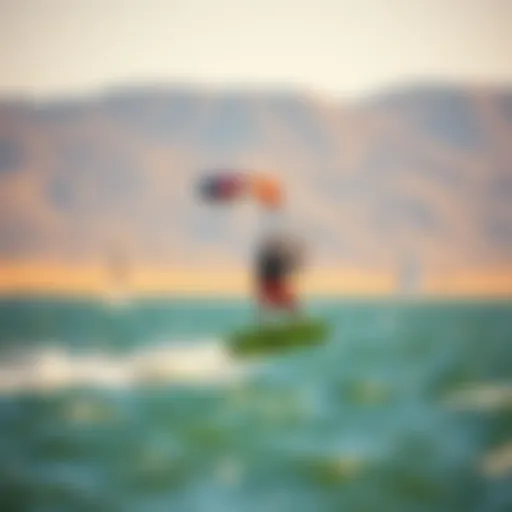Exploring the Versatile Role of Foil Bags in Kiteboarding


Intro
Kiteboarding isn’t merely about the thrill of catching wind and riding waves; it’s also about the gear that a rider employs and how to keep it in shape. One aspect that often doesn’t grab the spotlight but is quite pivotal in this sport, is the use of foil bags. These bags play a crucial role in protecting valuable equipment from potential damage during transport. Whether you are trekking to a local beach or jet-setting to a kiteboarding hotspot, using a quality foil bag can make all the difference. In this exploration, we'll break down the many facets of foil bags—from their construction to their importance in the kiteboarding realm.
Gear Insights
Latest Gear Reviews
When it comes to selecting a foil bag, you want to make sure you're going for products that have the reputation for durability and efficiency. Some of the latest bags on the market like Liquid Force’s Foil Travel Bag and Cabrinha's Kite Foil Bag have received rave reviews. These bags often come with added padding for protection and specialized compartments that help organize kiteboards, foils, and accessories seamlessly.
- Liquid Force Foil Travel Bag: Known for its lightweight design without compromising on protection. Customers rave about the ease of carrying it.
- Cabrinha Kite Foil Bag: This one combines style with utility, featuring a slick design and ample space for multiple gear setups.
Riders across forums, such as reddit.com, emphasize the importance of checking for waterproof features as well. After all, the last thing you want is for rain to dampen your fun.
Essential Gear for Beginners
For those just starting in kiteboarding, the right foil bag can be a game changer. An effective beginner's choice is the Naish Kites Foil Bag. It’s somewhat simpler and less expensive compared to others, but it's still robust enough to provide substantial equipment protection.
- Storage Capacity: Make certain there’s enough room for your kite, board, and other necessary gear.
- Weight: Opt for a lighter bag to ease transport while heading to the beach.
Investing in a solid foil bag as a newbie won't just protect your gear but also make setup and breakdown a smooth process. Educating yourself about gear can take your kiteboarding experience from good to exhilarating.
Techniques and Tips
Advanced Tricks and Techniques
Safety is key when practicing advanced tricks. Using a foil bag that's easy to access can help you quickly retrieve gear in case of an emergency. Several kiteboarders have shared stories about how they avoided accidents because they could reach their safety equipment without fumbling around.
- Quick Access: Make sure your foil bag has quick-access compartments for essentials such as a rescue knife or emergency signal.
- Secure Fastenings: Look for zippers and straps that assure the bag stays shut even in rough conditions.
Safety Practices for Kiteboarders
Safety practices can be improved with the right gear. A well-constructed foil bag not only protects your kite but also stores your safety accessories in an organized way. You'll want to keep items like a first aid kit, compass, or water bottle in a designated spot within the bag.
"A fool-proof bag ensures that everything you might need is right at your fingertips without sifting through a chaotic mess."
Incorporating a solid safety protocol starts from the moment you gear up for your ride. Understanding the gear you carry is as important as the skills you practice on the water.
By digging into these aspects of foil bags in kiteboarding, enthusiasts can see just how vital these seemingly simple products are for achieving a better, safer, and more enjoyable kiteboarding experience.
Preamble to Foil Bags in Kiteboarding
Foil bags hold a vital place in the arena of kiteboarding, acting not just as mere storage, but as fundamental gear that caters to both the protection and usability of kiteboarding equipment. In the fast-paced and often rugged environments where kiteboarding enthusiasts thrive, having the right protective gear can make a world of difference. As kiteboarders transport their gear across varying terrains, from beach sands to rocky shores, foil bags prove essential in safeguarding not only the expensive equipment but also the safety of the riders themselves.
Defining Foil Bags
Foil bags are specifically designed storage solutions tailored for various kiteboarding components, including kites, boards, harnesses, and lines. Oftentimes, these bags feature padded compartments to cushion the delicate fabrics and materials from wear and tear. The construction usually incorporates high-quality, weather-resistant materials, ensuring performance, durability, and longevity.
For kiteboarders, foil bags come in various shapes and sizes, suiting different preferences and storage needs. Whether a rider is heading out for a casual day at the beach or gearing up for an extended trip, the versatility in design assists in efficiently packing essential gear. Many users appreciate the lightweight nature of these bags, which doesn't add unnecessary bulk.
Importance of Foil Bags in Gear Protection
Foil bags serve a crucial role in protecting kiteboarding gear from potential damage. Think about it: you're packing up after an exhilarating day riding the waves, tired yet elated, and then you accidentally drop your kite. The result could be a puncture, leading to a very unfortunate day. That's where foil bags come into play; they provide that extra buffer against the wear and tear that often comes with transport and storage.
The advantages of utilizing foil bags are numerous:
- Protection Against Elements: With many foil bags incorporating waterproof features, the risks associated with rain and moisture on delicate fabrics are significantly reduced.
- Impact Resistance: Padded compartments ensure that any bumps during travel won’t leave permanent marks, keeping the kites and boards in pristine condition.
- Organization: These bags often come with varying pockets and compartments, making sure that everything has its place, reducing the chances of losing essential kit items.
"Investing in a quality foil bag can mean the difference between regular repairs and prolonged equipment life."


In summary, foil bags offer kiteboarding enthusiasts a solution for protecting their significant investments while simultaneously providing convenience and organization during travels. With knowledge about foil bags and their practical benefits, kiteboarders can focus on what they do best: enjoying the ride.
Materials Used in Foil Bags
Materials play a vital role in the performance and longevity of foil bags used in kiteboarding. The right choice of materials not only affects the bag's durability but also its overall functionality and how well it protects the gear inside. Kiteboarders, whether they're seasoned professionals or weekend warriors, rely on bags that can endure the rigors of both travel and harsh weather conditions. Understanding the specific elements and benefits of the materials used in foil bags is essential for everyone looking to make a wise investment in their gear.
Polyester and Its Properties
Polyester is a popular material for foil bags, and there's a good reason for that. It's lightweight yet offers impressive strength, which is crucial when lugging around kiteboarding gear. Polyester fibers resist tearing, allowing the bags to hold up against the rough handling that often comes with travel. Another advantage is its water-resistant nature. While it won't keep water out entirely, it does help in repelling moisture, providing a layer of protection on those soggy days at the beach.
From a maintenance standpoint, polyester is relatively easy to clean. A simple wipe-down with a damp cloth is often enough to keep it looking sharp. Furthermore, many manufacturers incorporate UV-resistant treatments to prevent fading from sun exposure, which is an essential consideration for travelers frequenting bright, sunny destinations.
Nylon’s Durability and Benefits
When it comes to durability, nylon is often considered the heavyweight champion in the world of materials. Known for its incredible tensile strength, nylon foil bags can withstand significant wear and tear, making them ideal for handling the inevitable bumps and scrapes of kiteboarding trips. One standout feature of nylon is its resistance to abrasion, which means it won’t easily wear out against rough surfaces, ensuring that your valuable gear stays protected.
Additionally, nylon is naturally more elastic than other materials. This elasticity aids in shock absorption, which is crucial when bags are tossed around during travel. It also offers excellent water resistance; many nylon bags come with coatings that enhance their hydrophobic properties, making them a reliable option for those who may find themselves caught in a sudden downpour.
Foam Padding for Enhanced Protection
Foam padding is a game changer when it comes to protecting kiteboarding equipment, and it’s often a defining feature of high-quality foil bags. The padding acts as a buffer against impacts, which is particularly important in high-stress environments, such as busy airports or when packing gear in the back of a vehicle. A well-padded foil bag can mean the difference between a triumphant session on the water and a broken board or damaged kite.
Moreover, certain foam materials are designed to absorb shocks without adding too much weight to the bag itself, striking a perfect balance between protection and portability. Options like closed-cell foam not only provide excellent cushioning but are also water-resistant, adding an extra layer of defense against moisture.
In summary, the materials used in foil bags—polyester, nylon, and foam padding—each bring unique benefits that significantly enhance the functionality and versatility of these essential kiteboarding accessories.
When investing in a foil bag, considering these materials can guide kiteboarders toward making choices that best fit their specific needs and travel habits. Whether it's the lightweight convenience of polyester, the durability of nylon, or the protective qualities of foam padding, each aspect contributes to a better kiteboarding experience.
Design Features of Foil Bags
The design of foil bags plays a crucial role in how effectively they serve kiteboarders. It is not simply about looks or aesthetics; practical design elements can greatly enhance usability, convenience, and overall function. As kiteboarding equipment tends to be bulky and needs special handling, the bags designed to carry them must address these challenges effectively. Each feature, from storage compartments to adjustable straps, contributes to making the kiteboarding experience smoother and more enjoyable.
Optimized Storage Compartments
Storage compartments in foil bags are not just arbitrary spaces; they are strategically designed to accommodate various kinds of kiteboarding gear. Every pouch and section offers a dedicated spot for essential components like kites, bars, and boards, helping to maintain organization. Having well-defined compartments helps prevent gear from shifting during transport, reducing the risk of equipment damage.
- Benefits of Optimized Storage Compartments:
- Enhanced Organization: A place for everything means less chance of losing gear.
- Space-efficient design: Maximizing the bag's capacity saves space when traveling.
- Quick Access: Easily find what you need without rummaging around.
For instance, a bag with a specific compartment for a kite's lines minimizes tangling, while an extra pocket can hold smaller items, ensuring nothing gets overlooked.
Adjustable Straps for Comfort
When it comes to lugging around your kiteboarding gear, comfort is king. Adjustable straps make all the difference, especially when you're hunting for that perfect spot at the beach or navigating through bustling airports. A well-designed strap system caters to users of different heights and carries, promoting a custom fit.
- Key Considerations:
- Weight Distribution: Properly designed straps help in distributing weight evenly, reducing strain on the back and shoulders.
- Versatility: Straps that adjust allow for different carrying methods – be it over the shoulder or as a backpack.
The importance of comfort in carrying cannot be overstated; a few extra adjustments can lead to a world of difference when you’re hauling gear on a long trek.
Weather Resistance and Waterproofing
Kiteboarding inherently involves exposure to elements, so it's vital for foil bags to stand up to weather conditions. Wind, rain, and ocean spray can all take a toll on gear if precautions aren’t taken. Therefore, many modern foil bags come with weather-resistant materials and waterproof linings.
- Why This Matters:
- Protection from Elements: Keeps equipment dry and reduces the risk of premature wear.
- Durability: Materials resistant to UV rays and saltwater prolong the life of the bag.


The significance of weather resistance cannot be ignored. A waterproof bag protects not only against rain, but also from salt corrosion and the occasional splash while riding.
"The right design features in foil bags can mean the difference between swift transitions on the beach and struggling with a cumbersome load."
In summary, the design features of foil bags enhance the functionality significantly. They address the specific needs of kiteboarders, whether it’s organized packing, comfortable transport, or protection from elements. These features ensure that regardless of the journey or conditions, the gear remains safe and accessible.
Utilizing Foil Bags for Transport
Foil bags play an indispensable role when it comes to the transport of kiteboarding equipment. They serve not merely as carriers but are crucial for the safety and organization of those valuable items that kiteboarders rely on. The unique way in which these bags are designed highlights their importance—it’s not just about getting your gear from point A to B; it’s about doing so with peace of mind knowing that each piece is secured and protected. Whether you’re heading to the beach or traveling across countries, understanding how to make the most of foil bags can elevate your kiteboarding experience significantly.
Packing Technique for Optimal Use
When it comes to packing your foil bag, a little technique goes a long way. First, it’s best to start with the largest components of your gear. Lay the kite, for example, in the flat bottom of the bag, ensuring there are no twists or folds, as this not only keeps it safe but also makes it easier to access later. Layering equipment is also a smart approach; putting items like the board and harness in a specific order can save room.
- Follow these guidelines for packing efficiently:
- Begin with the base items—like your kite and board.
- Add smaller items, organizing by size and fragility.
- Utilize compartments wisely for easy reach.
Another clever trick is to use socks or worn clothing to cushion any hard edges or delicate pieces. This method not only protects the gear from dings but also maximizes space. Additionally, keep an eye on the weight distribution; weighing down one side can lead to awkward handling, especially during transport.
Travel Considerations and Tips
Preparing for travel with foil bags requires keen attention to detail. Knowing what to expect can help you sidestep potential mishaps. First off, check the airline regulations if you’re flying—most have specific policies regarding oversized luggage, which often includes kite bags. Always measure your bag beforehand.
Moreover, don’t underestimate the importance of using a sturdy brace or frame inside your foil bag. This can prevent your gear from shifting around, reducing the risk of damage. Additionally:
- Be mindful of local climates: If you're heading to a place with moisture, consider bringing extra waterproofing bags to protect your gear.
- Durability matters: Choose a bag with resilient material to withstand the rigors of travel.
- Create a packing list to ensure no item gets left behind, especially on a spontaneous kiteboarding adventure.
In sum, utilizing foil bags for transport involves more than just loading up and heading out. It’s about establishing a routine and understanding the tools at your disposal. Engaging in thoughtful packing techniques and paying attention to travel tips will not only safeguard your equipment but also enhance your overall kiteboarding experience.
Care and Maintenance of Foil Bags
When it comes to kiteboarding, maintaining the integrity of your gear is just as important as mastering your skills on the water. Foil bags are designed for protection, convenience, and ease of transport, but neglecting their upkeep can lead to premature wear and tear. Striking a balance between usage and maintenance ensures that your bags serve their purpose effectively, safeguarding your valuable equipment.
Cleaning and Storage Best Practices
Keeping your foil bags clean is essential. Sand, salt, and moisture can be real enemies, eating away at the fabric and compromising the seams. Here are some best practices to keep in mind:
- Rinse After Use: After a long day on the water, rinse your foil bag with freshwater. Make it a habit. Getting rid of salt and sand prevents damage and keeps your bag looking sharp.
- Use Mild Detergents: If your bag needs a thorough clean, use mild soaps that won't harm the material. Avoid bleach and strong chemicals. They can weaken fabrics and ruin waterproofing.
- Dry Properly: Always air-dry your foil bag completely before storing. If it’s wet or damp, mold can grow. Hang it in a shaded area where it can breathe. Direct sunlight can also weaken the UV protection, so mind where you leave it.
- Storing Safely: Keep your foil bag in a dry, cool place. Avoid cramming it into tight spaces where it might get squished or creased. Ideally, place it flat or hang it to maintain its shape.
Adhering to these practices will help maintain the performance of your bags, ensuring they last longer while also protecting your kiteboarding gear from damage.
Repair Techniques for Long-Lasting Use
Even with proper care, wear and tear is sometimes inevitable. Learning basic repair techniques can significantly extend the life of your foil bag. Here’s how to patch up your bag before it becomes a problem:
- Assess the Damage: Check your bag regularly for any signs of fraying, small tears, or damaged zippers. Catching these early means you can often fix them easily.
- Use Repair Patches: Many brands offer repair patches specifically designed for kiteboarding gear. Simply clean the area around the tear and adhere the patch according to the manufacturer’s instructions. This can prevent larger tears and prolong the life of the bag.
- Sewing Tears: If you’re handy with a needle and thread, sewing small rips is doable. Use a heavy-duty thread for extra durability. Reinforce the seam by going back and forth several times.
- Reinforce Stress Points: Areas where the straps connect to the bag are common stress points. Reinforcing these with additional material can help prevent future damage.
Keeping your equipment in top shape allows you to focus on what you love—the exhilarating ride over the waves. Remember, a little care goes a long way.
"A well-cared-for foil bag is not just a piece of equipment; it's an investment in your kiteboarding adventure."
By implementing these cleaning and repair techniques, you ensure your foil bag remains an asset rather than a liability. In the long run, it’s all about protecting your essential gear while enjoying the sport you love.
The Role of Foil Bags in Kiteboarding Safety
When it comes to kiteboarding, safety should never be an afterthought. This is where foil bags step up to the plate, acting as a first line of defense for both gear and riders. They don’t just provide a snug home for your equipment; their structural and design features significantly improve on-field safety. As the sport becomes increasingly adventurous, understanding the crucial role of foil bags becomes imperative for both novices and seasoned veterans alike.
Protection for Equipment and Riders


One of the standout features of foil bags is their ability to shield kiteboarding gear from harsh elements and rough handling. These bags typically come with robust outer materials, like polyester or nylon, which resist wear and tear. It’s like giving your expensive gear a raincoat in a storm.
Consider this: when you’re traveling to that hidden spot you’ve read about online, your gear might take a beating. The last thing you want is a damaged kite or broken board just before hitting the waves. A well-constructed foil bag cushions your gear against impacts, keeping the inflatables and hard components in pristine condition.
But protection does not stop at gear. The bags also help ensure rider safety. When stored incorrectly, loose equipment can become dangerous projectiles during transport. In extreme cases, an unguarded board could easily injure a fellow traveler.
"A foil bag is not just an accessory; it's a safety investment".
This protection is particularly valuable in social heavy scenarios such as competitions or crowded beaches, where accidents can happen in the blink of an eye. By securely stowing your gear, you significantly reduce the risk of injury to yourself and others.
Considerations for High-Impact Environments
The reality of kiteboarding is that it’s often not a walk in the park. Many riders brave tough conditions, whether it’s rocky shores or bustling hot spots with other enthusiasts. In these high-impact environments, the role of foil bags becomes even more vital.
First off, the materials used in these bags need to be top-notch. Nylon may come at a premium but its resistance against punctures is invaluable when you consider a stray rock catching your bag. Likewise, thermal linings can aid when gear is subjected to extreme temperatures, both hot and cold.
Moreover, the design of the bag really matters here. Look for features like reinforced corners and heavy-duty zippers that can withstand abrasions and tears. Think of these as the extra armor for your gear, fending off the risks that come with the sport.
In places where winds can whip up without warning, your foil bag should also feature weather-resistant properties, such as waterproof inner linings. This is especially crucial when you’re out on the water and want to keep your spare gear dry.
Ultimately, it's not only about packing your gear securely but also about having a strategy to keep safety as a priority in adverse conditions. Employing well designed foil bags allows riders to focus on the joy of kiteboarding without worrying about the integrity of their gear or their own well-being.
Industry Trends and Innovations in Foil Bags
In the ever-evolving world of kiteboarding, the gear we use, including foil bags, must adapt to meet changing demands. The importance of staying updated with trends and innovations in foil bags cannot be understated, as these elements significantly enhance our experience in the water and during transport. As kiteboarders, we constantly seek solutions that not only protect our gear but also align with our lifestyle and environmental values. Understanding emerging materials and advancements in design can pave the way for smarter, more efficient products that cater to our needs.
Emerging Materials and Sustainability
The quest for sustainable practices in kiteboarding industry has led to the exploration of innovative materials that offer both performance and environmental benefits. Kiteboarders today are more conscious about their choices. They want products that reduce their carbon footprint while remaining functional.
- Recycled Polyester and Nylon: Recent innovations have introduced recyclable versions of popular materials like polyester and nylon. These fabrics maintain durability while minimizing waste in landfills. Using these materials not only keeps gear safe but also gives kiteboarders peace of mind knowing they are making eco-friendly choices.
- Biodegradable Options: Companies are experimenting with biodegradable materials, which decompose over time, reducing long-term environmental impact. Though still in early stages, these materials promise potential effectiveness in the years to come.
- Lightweight And Strong Designs: New technologies are allowing for lighter and stronger materials to be developed, which contributes to easier transport and better overall performance on the water. This represents a departure from traditional heavy materials that often weighed down gear bags.
It’s clear that the kiteboarding community is embracing these sustainable innovations, moving toward a future where performance and environmental responsibility can coexist.
Advancements in Design and Functionality
As kiteboarding grows more popular, the demands on foil bag design become more complex. Recent advancements focus on creating bags that cater to the needs of all kiteboarders, from the weekend warrior to the serious competitor. Some of the notable developments include:
- Modular Storage Solutions: New designs incorporate flexible compartments that allow users to customize storage based on their specific gear needs. This versatility makes it easier to pack everything you might need for a day at the beach.
- Enhanced Padding: There’s been significant improvement in padding technologies. Modern foil bags often feature increased padding at key impact zones. This translates to better protection for your equipment, especially in high-risk situations like airline travel.
- Ergonomic Designs: Companies are prioritizing comfort in bag designs, introducing ergonomic straps and back panels to ease transport. This consideration is crucial for individuals carrying heavy loads over long distances.
- Integrated Safety Features: Some foil bags now come with reflective materials or bright colors, ensuring visibility in low-light situations. This is vital for safety, especially when kiteboarding during dawn or dusk.
Adapting to market needs has never been more crucial. The kiteboarding industry’s trends toward sustainability and innovative design demonstrate a clear dedication to enhancing user experience.
With these trends and advancements, kiteboarding equipment, particularly foil bags, continues to evolve, resulting in safer, more user-friendly options for both novices and seasoned experts alike.
Culmination: The Future of Foil Bags in Kiteboarding
As the kiteboarding landscape continues to evolve, so too does the role of foil bags in safeguarding gear and enhancing the experience on the water. Kiteboarders are finding that the right foil bag isn’t just about protection; it’s about adaptability, convenience, and progression within the sport. With advances in materials and designs, foil bags are becoming not only more durable but also lighter and more versatile.
Adapting to Evolving Kiteboarding Needs
The kiteboarding community is always changing, with new techniques, tricks, and equipment being developed. This constant progression puts pressure on manufacturers to assess and adapt the designs of their foil bags regularly.
Innovations like modular compartments, which allow for customized storage solutions, are gaining popularity. This means kiteboarders can configure their bags based on the specific gear they use for a session, be it a smaller kite for a light wind day or a larger board for tricks. The implementation of ergonomic features, such as padded back straps and adjustable harness systems, ensures comfort during transport, addressing the practical concerns of passionate kiteboarders who haul their gear to various remote locations.
Sustainable practices are another significant aspect of future foil bag designs. More brands are leaning toward eco-friendly materials that provide high-performance levels without compromising the environment. This not only appeals to the conscientious consumer but also sets a standard in the industry that prioritizes preserving our natural playgrounds.
Final Thoughts on Gear Protection
Reflecting on the integral role foil bags play in protecting kiteboarding gear, it’s clear they are more than just an accessory. Properly maintained and thoughtfully designed foil bags can extend the life of expensive equipment by providing a sturdy barrier against abrasive elements and potentially damaging impacts.
"Investing in a high-quality foil bag is investing in your sport – the protection it provides is invaluable."
Moreover, users must understand what to look for: effective weather resistance, trustworthy stitching, and overall structural integrity are vital indicators of a good foil bag. As the sport’s demands rise, so does the expectation for gear longevity, pushing manufacturers to innovate further. Seeing that the kiteboarding community’s emphasis on safety and performance continues to grow, one can expect that foil bags will evolve accordingly, staying relevant and functional for generations to come.
In summary, the future of foil bags in kiteboarding is a reflection of the sport’s growth. They will need to adapt to changing needs while providing unmatched protection, sustainability, and convenience for kiteboarders around the world. With this in mind, choosing the right foil bag is crucial, not just for today’s gear but for the kiteboarding adventures of tomorrow.















